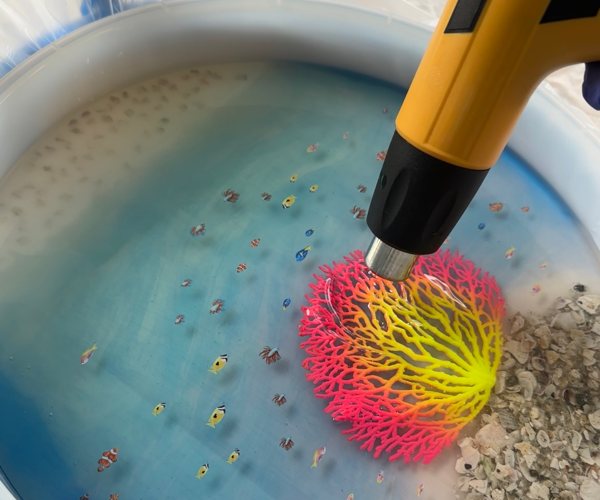Epoxy resin is a remarkable finishing material that goes on a surface as a soft, flowing liquid, but cures to a incredibly durable, crystal-clear sealant.
However, to achieve the perfect cure, there are several steps involved that require a little bit of effort and care. There's the measuring step in which you pour the epoxy components into a container at an appropriate ratio.
There's also the mixing and pouring steps, in which you prepare and apply to resin to your intended substrate material.
Air bubble removal: an essential phase for a perfect cure
Beyond the pouring step is the air bubble removal phase. This brief phase has a significant effect on the final appearance of the epoxy finish. Removing air bubbles as they attempt to surface in your resin coating prevents them from being suspended in the final finish, keeping it clear and free of such blemishes.
Typically, air bubble removal involves using a heat gun. This is an electric tool that gently sends out a constant stream of heated air. When applied to an uncured epoxy layer, the high heat bursts any air bubbles at or near the surface, causing the air trapped inside to disperse and allowing the epoxy to settle.
But is a heat gun needed for resin? Or are there other options? In this article, we'll explain how essential a heat gun is, and why it is usually the tool we recommend for this purpose.
Do you need a heat gun for resin?
To achieve an optimal finish or cure, epoxy resin is often kept in particular environments, with each step being handled in a certain way.
One of the smaller steps of the epoxy resin process involves removing air bubbles.
How air bubble removal is accomplished
During the air bubble removal step, a heat gun is held several inches away from the surface of the epoxy layer, then carefully moved back and forth in smooth motions over the entire surface until a complete pass has been done.
Once that first pass has been done, most users will then closely examine their coating to see if there are still air bubbles present. Another pass can then be performed as needed.
Though in most cases a heat gun is what is used for this phase of the process, there is another option available. Instead of a heat gun, you can also use a blowtorch.
Blowtorches: a heat gun substitute.
This type of tool comes in different forms, determined by the type of fuel it uses, e.g., butane torches and propane torches,.
Blowtorches are an excellent choice for clearing out air bubbles. They don't put a lot of pressure out, so the resin coating is unlikely to get more air induced into it.
The one downside to a blowtorch is that you need to be more careful when using it. It's essential to never allow the flame to touch the epoxy, as that can cause immediate heat damage while it's in such a state.
Otherwise, the blowtorch process is very similar to using a heat gun. Move smoothly over the entire epoxy surface, several inches away, until you've done a complete pass.
Always be sure not to linger, as heat builds up rapidly with either of these implements. And of course, check the condition of your coating after each pass to see if any air bubbles were missed.
What to do after air bubble removal
Once you've finished removing air bubbles with your heat gun or torch, all you have left is to let the epoxy cure. If the epoxy is high quality, you shouldn't have any issues provided you followed the instructions.
A partial cure of at least 4 hours is necessary even if you intend to add a second layer; however, if you're not adding additional layers, it's important to give your resin coating adequate time to fully cure. This takes about 72 hours for a standard table top or countertop epoxy project.
Click here to learn more about curing.
Additional Resources
Here are some additional resources you may find useful:
- Guidelines for cleaning epoxy surfaces - Learn how to keep your finish looking clean and good as new.
- Epoxy for beginners: Basic project tools and supplies - Our guide to the various tools and supplies used in most epoxy projects.
- Is table top epoxy heat resistant? What can it handle? - Discover where epoxy's limits lie with regard to heat.
Have questions? Want advice? Contact us!
If you have any questions about sanding between epoxy coating applications, or if you'd like assistance in planning an epoxy project, please reach out to us at UltraClear Epoxy—our epoxy experts are ready to assist!
You can contact us via phone or email here. During business hours, you can also text chat online with one of our resin specialists by clicking the Help button at the bottom of your screen.
In our online store, you'll find a variety of useful tools and supplies, ideal for resin projects, plus our award-winning UltraClear Bar & Table Top Epoxy and our UltraClear Deep Pour Epoxy.













